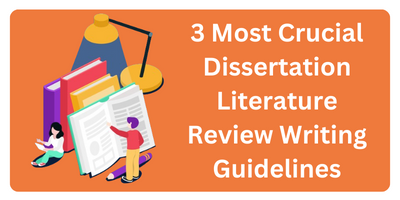
 Starting a dissertation? Learn key tips with our blog on the 3 most important guidelines for writing a dissertation literature review. These easy-to-follow rules will guide you through the challenging process of academic writing. Get ready for expert advice and helpful tips to make your literature review strong and convincing!
Starting a dissertation? Learn key tips with our blog on the 3 most important guidelines for writing a dissertation literature review. These easy-to-follow rules will guide you through the challenging process of academic writing. Get ready for expert advice and helpful tips to make your literature review strong and convincing!
Dissertation Literature Review Writing Guidelines are a set of principles that direct the process of evaluating, summarizing, and synthesizing existing research within a dissertation. These guidelines ensure a systematic and comprehensive analysis of relevant literature, helping students situate their research within the academic landscape.
By adhering to these guidelines, scholars enhance the credibility and depth of their research, providing a solid foundation for their own contributions. Effectively navigating these guidelines is pivotal for producing a well-rounded and impactful dissertation. So, let’s start this blog with the correct literature review structure (see the Note also).
Clearly state the purpose and scope of your literature review.
Introduce the key themes or concepts you will be exploring.
Group relevant studies and sources into themes or categories.
Discuss each category’s significance in relation to your research.
Analyse each study’s advantages and disadvantages.
Highlight any gaps in existing research that your dissertation aims to fill.
Connect different studies to show trends, patterns, or contradictions.
Emphasize how the literature supports or challenges your research question.
Summarize the main findings and their implications.
Discuss the contributions your dissertation will make to the existing body of knowledge.
Note: The steps in writing a dissertation literature review involve organizing your thoughts logically, critically analyzing sources, synthesizing information, and concluding with the potential impact of your research. Keep your focus on clarity, coherence, and relevance throughout the review.
Now, let us dive into the 3 lesser-known yet important dissertation literature review writing guidelines which can help us to jumpstart our research.
Holistic contextualization encourages placing each study within a broader context. PhD researchers gain a more comprehensive understanding of the literature’s intricate connections, ensuring a thorough grasp of the subject matter.
This approach involves considering socio-cultural, historical, or theoretical landscapes. Researchers can identify patterns and trends that might be obscured in a narrow analysis. Recognizing these nuances enhances the overall structure of dissertation literature review.
Acknowledge the broader context to strengthen the foundation for your research. PhD researchers can build a more robust research foundation by understanding the broader academic discourse. This informs the design and execution of their own research.
Moving beyond individual study summaries. Holistic contextualization facilitates a more nuanced critical analysis, helping researchers assess the strengths and weaknesses of studies in a richer context.
Connect studies across disciplines. PhD researchers can synthesize information from various fields, offering a more integrated and innovative perspective. This interdisciplinary approach contributes to the overall structure of dissertation literature review.
Guideline: Integrate personal reflections on biases and assumptions throughout the review.
Benefits: Reflexive engagement promotes transparency, showcasing the researcher’s self-awareness and fostering an authentic connection with the literature. This enhances the overall structure.
Guideline: Acknowledge and reflect on evolving perspectives.
Benefits: PhD researchers can provide a more nuanced perspective by recognizing and addressing changes in their viewpoints. This adds depth to the analysis, making the literature review more insightful.
Guideline: Incorporate the researcher’s voice into the narrative.
Benefits: Reflexive engagement contributes to intellectual honesty, allowing researchers to acknowledge subjective positions. This honesty is crucial in creating a trustworthy and well-structured dissertation literature review.
Guideline: Integrate personal reflections to connect with the audience.
Benefits: By sharing personal insights, PhD researchers can establish a connection with readers. This engagement enhances the readability and impact of the literature review’s structure.
Guideline: Contribute to the ongoing scholarly conversation.
Benefits: Reflexive engagement adds value to the dissertation literature review by contributing the researcher’s unique perspective to the scholarly discourse. This elevates the overall structure of the review and positions it as a valuable scholarly contribution.
– Extend the literature review beyond the confines of the specific field.
– PhD researchers gain diverse perspectives by incorporating insights from related disciplines.
– This broadens the scope and enriches the overall structure of the dissertation literature review.
– Explore and integrate ideas from various academic areas.
– Interdisciplinary synthesis allows researchers to draw connections between seemingly unrelated concepts.
– This innovation enhances the steps in writing a dissertation literature review, fostering a more creative and impactful narrative.
– Incorporate interdisciplinary sources to provide a comprehensive perspective.
– Researchers can achieve a more holistic understanding of their topic by considering a range of disciplines.
– This holistic approach strengthens the structure of the literature review.
– Draw from varied fields to uncover novel insights.
– PhD researchers can identify gaps in existing research by exploring interdisciplinary sources.
– This awareness contributes to the steps in writing a dissertation literature review, helping researchers position their work within the broader scholarly landscape.
– Foster a more holistic understanding of the research topic.
– By embracing interdisciplinary synthesis, PhD researchers can elevate the impact of their research.
– This broader perspective enhances the steps, positioning the work as a valuable contribution to multiple academic domains.
To wrap it up, understanding the dissertation literature review writing guide is crucial for PhD researchers. These three guidelines might not be the first things that come to mind, but they’re like hidden gems that can truly enhance your work.
By looking at studies in a bigger picture (that’s holistic contextualization), you can see things others might miss and understand the subject more deeply. Adding your own thoughts and reflections (that’s reflexive engagement) brings a personal touch, making your review more real and relatable. And when you bring in ideas from different areas (interdisciplinary synthesis), you open the door to new connections and perspectives.
Phdtutor.in is a website that provides comprehensive support to research scholars at every stage of their PhD journey, from topic selection to writing a thesis and its review. The website offers a range of services, including assistance with finding the best tutors, the kind of services they provide, and how they would assist students in their studies. The website also provides free samples to scholars and connects them with distinguished PhD writers, editors, and statisticians.
Phdtutor.in is a one-stop solution for all PhD-related queries and concerns. The website’s team of experts is highly experienced and provides guaranteed results. The website also offers a range of services, including PhD topic selection help, PhD research proposal, PhD synopsis, research design, finalizing research questions and objectives, questionnaire designing, data analysis using SPSS AMOS, software implementation using Matlab Simulink, NS2, NS3, Java, Python, HFSS, CST, Ansys, journal paper development, and more.
The key elements in writing a Dissertation Literature Review include a clear introduction, organized synthesis of existing research, critical analysis, and a thoughtful conclusion.
The requirements for a Dissertation Literature Review involve thorough research, proper citation of sources, and a structured presentation of existing knowledge.
Gap areas in the literature review can be identified by recognizing inconsistencies, contradictions, or areas with limited research coverage.
The three major sources of a literature review are academic journals, books, and reputable online databases.
Leave a Reply